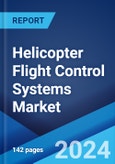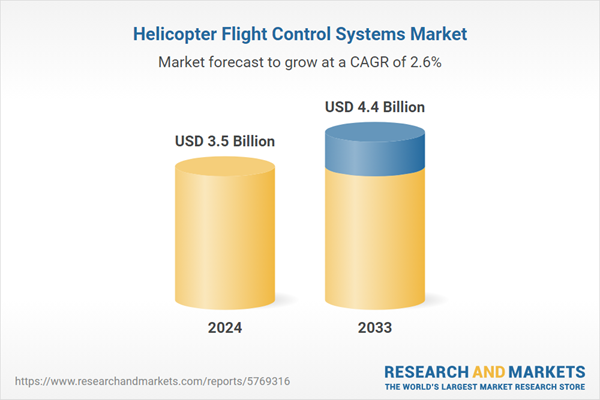Helicopter Flight Control Systems Market Analysis:
Market Growth and Size: The global helicopter flight control systems market is witnessing stable growth, driven by increasing demand for helicopter services across various industries.Major Market Drivers: Key drivers include technological advancements, such as fly-by-wire systems and automation, as well as the escalating demand for helicopter services in sectors like offshore oil and gas, emergency medical services, and defense.
Technological Advancements: Innovations in sensor integration, automation, and eco-friendly flight control systems are facilitating the market growth.
Industry Applications: Flight control systems find applications in commercial aviation, business aviation, and military aviation.
Key Market Trends: Key trends include the integration of urban air mobility (UAM) initiatives, retrofitting of older helicopter models with modern flight control systems, and a focus on cost-effective solutions.
Geographical Trends: North America leads the market due to robust aerospace and defense industries. However, Asia Pacific is emerging as a fast-growing market, driven by economic development and infrastructure projects.
Competitive Landscape: Key players are investing in research and development (R&D), expanding their global presence through partnerships, and offering comprehensive aftermarket support. They are also addressing regional requirements to maintain a competitive edge in the market.
Challenges and Opportunities: Challenges include meeting stringent safety standards and evolving regulatory requirements. Nonetheless, opportunities for developing advanced flight control systems that address environmental concerns are projected to overcome these challenges.
Helicopter Flight Control Systems Market Trends:
Advancements in Technology
The helicopter flight control systems are significantly influenced by ongoing advancements in technology. These advancements are revolutionizing the way helicopters are controlled, making them safer, more efficient, and versatile. Moreover, the implementation of fly-by-wire systems is propelling the market growth. Unlike traditional mechanical control systems, fly-by-wire systems use electronic sensors and computers to interpret pilot inputs and adjust the control surfaces of helicopters. This technology allows for precise control and stabilization, even in challenging flight conditions. Additionally, the integration of advanced sensors and automation further enhances the capabilities of flight control systems. Inertial navigation systems, global positioning systems (GPS), and radar sensors provide real-time data to assist pilots in navigation and obstacle avoidance. Automation features, such as autopilots and stability augmentation systems, reduce the workload on pilots, enabling them to focus on mission-critical tasks. These advancements not only improve safety but also increase the overall performance and reliability of helicopters, making them more attractive to a wide range of industries.Rising Demand for Helicopter Services
The increasing demand for helicopter services across various sectors is impelling the growth of the market. Helicopters are indispensable in critical applications, such as offshore oil and gas exploration, where they transport personnel and equipment to remote locations. They are also vital in emergency medical services (EMS), providing rapid transportation for patients in critical condition. Furthermore, helicopters play a crucial role in law enforcement, search and rescue operations, and tourism. The demand for efficiency in these industries, coupled with the need for swift and reliable transportation solutions, is driving the adoption of advanced flight control systems. Helicopters equipped with sophisticated control systems can operate more efficiently, reducing turnaround times and operational costs. As the demand for these services continues to rise, there is a corresponding need for flight control systems that enhance the safety and effectiveness of helicopter operations.Focus on Safety and Pilot Assistance
Safety remains a paramount concern in the aviation industry to maintain the security of passengers and crew members. Flight control systems are evolving to prioritize safety features and provide critical pilot assistance. These systems are equipped with features like autopilots, which can maintain stable flight even in turbulent conditions, reducing pilot fatigue and the risk of accidents. Additionally, stability augmentation systems enhance the stability and control of the helicopter, especially during complex maneuvers or adverse weather conditions. Terrain awareness and warning systems (TAWS) contribute to safety by alerting pilots to potential terrain hazards, helping to prevent accidents related to controlled flight into terrain (CFIT). The unwavering commitment of the aviation industry to reducing accidents and incidents is contributing to the market growth. These systems not only enhance safety but also instill confidence in operators, making helicopters a dependable choice for various missions. As the industry continues to prioritize safety, flight control systems will play a crucial role in achieving this goal, further fueling market growth and innovation.Helicopter Flight Control Systems Industry Segmentation:
The publisher provides an analysis of the key trends in each segment of the market, along with forecasts at the global, regional, and country levels for 2025-2033. Our report has categorized the market based on type and application.Breakup by Type:
- Primary Flight Control System
- Secondary Flight Control System
Primary flight control system accounts for the majority of the market share
The report has provided a detailed breakup and analysis of the market based on the type. This includes primary flight control system and secondary flight control system. According to the report, primary flight control system represented the largest segment.Primary flight control systems are the backbone of helicopter control, responsible for the core functions like pitch, roll, and yaw. These systems directly manipulate the main control surfaces of a helicopter, such as the main rotor, tail rotor, and swashplate. Due to their critical role in ensuring the fundamental stability and maneuverability of helicopters, primary flight control systems are in high demand across various industries, including military, commercial aviation, and emergency services. Their reliability, precision, and safety-enhancing features make them an indispensable component in modern helicopter operations.
Secondary flight control systems are responsible for fine-tuning and optimizing the performance of the helicopter. Their adoption varies depending on the specific mission requirements and the degree of control sophistication needed. Industries like commercial aviation and high-performance military helicopters often incorporate secondary systems to fine-tune control responsiveness and stability.
Breakup by Application:
- Business Aviation
- Commercial Aviation
- Military Aviation
Commercial aviation holds the largest share in the industry
A detailed breakup and analysis of the market based on the application have also been provided in the report. This includes business aviation, commercial aviation, and military aviation. According to the report, commercial aviation accounted for the largest market share.Commercial aviation represents the largest segment in the market for helicopter flight control systems. This segment encompasses various applications, including passenger transport, offshore oil and gas support, aerial work, and more. Helicopters used in commercial aviation require advanced flight control systems to ensure the safety and efficiency of operations. These systems enable precise control during passenger transport, cargo delivery, and other commercial missions. The growing demand for helicopter-based services, such as air taxis and urban air mobility, further fuels the need for reliable flight control systems in the commercial aviation sector.
The business aviation segment includes the use of helicopters for corporate transportation, very important person (VIP) transport, and executive travel. Business aviation demands high levels of comfort, safety, and performance. Flight control systems play a crucial role in providing a smooth and secure flight experience for business travelers.
Military aviation is driven by defense and security applications. Helicopters are essential for various military missions, including troop transport, reconnaissance, search and rescue, and combat support. The flight control systems used in military helicopters are designed to meet stringent requirements for agility, survivability, and mission-specific functions.
Breakup by Region:
- North America
- United States
- Canada
- Asia Pacific
- China
- Japan
- India
- South Korea
- Australia
- Indonesia
- Others
- Europe
- Germany
- France
- United Kingdom
- Italy
- Spain
- Russia
- Others
- Latin America
- Brazil
- Mexico
- Others
- Middle East and Africa
North America leads the market, accounting for the largest helicopter flight control systems market share
The market research report has also provided a comprehensive analysis of all the major regional markets, which include North America (the United States and Canada); Asia Pacific (China, Japan, India, South Korea, Australia, Indonesia, and others); Europe (Germany, France, the United Kingdom, Italy, Spain, Russia, and others); Latin America (Brazil, Mexico, and others); and the Middle East and Africa. According to the report, North America accounted for the largest market share.The North America helicopter flight control systems market is driven by the increasing demand for helicopters in various sectors, including search and rescue, law enforcement, medical transport, and offshore oil and gas exploration. Additionally, the growing interest in urban air mobility (UAM) initiatives, which rely on helicopters and vertical take-off and landing (VTOL) aircraft, is bolstering the market growth. These emerging UAM services are spurring innovation in flight control systems to support urban transportation needs.
Asia Pacific maintains a strong presence driven by the increasing adoption of helicopters for medical evacuation, tourism, and infrastructure development.
Europe stands as another key region in the market, driven by the retrofitting of older helicopter models with modern flight control systems to enhance performance and safety.
Latin America exhibits growing potential in the helicopter flight control systems market for a range of applications, including agricultural and forestry operations, tourism, and emergency medical services.
The Middle East and Africa region show a developing market for helicopter flight control systems, primarily driven by the increasing demand for ruggedized flight control systems capable of withstanding harsh environmental conditions.
Leading Key Players in the Helicopter Flight Control Systems Industry:
The key players in the helicopter flight control systems market are actively engaged in several strategic initiatives to stay competitive and meet evolving industry demands. These initiatives include continuous research and development (R&D) efforts to enhance flight control system technology, with a focus on automation, sensor integration, and safety features. Additionally, they are expanding their global presence through partnerships, collaborations, and acquisitions to access new markets and strengthen their customer base. Key players are also investing in sustainability efforts, developing eco-friendly flight control systems to align with growing environmental concerns. Furthermore, they are offering comprehensive aftermarket support and maintenance services to ensure the reliability and longevity of their systems, thereby fostering customer loyalty and satisfaction.The market research report has provided a comprehensive analysis of the competitive landscape. Detailed profiles of all major companies have also been provided.
Some of the key players in the market include:
- Liebherr
- Moog Inc.
- Raytheon Technologies Corporation
- Safran S.A.
- Woodward Inc.
Key Questions Answered in This Report
- How big is the global helicopter flight control systems market?
- What is the expected growth rate of the global helicopter flight control systems market during 2025-2033?
- What are the key factors driving the global helicopter flight control systems market?
- What has been the impact of COVID-19 on the global helicopter flight control systems market?
- What is the breakup of the global helicopter flight control systems market based on the type?
- What is the breakup of the global helicopter flight control systems market based on the application?
- What are the key regions in the global helicopter flight control systems market?
- Who are the key players/companies in the global helicopter flight control systems market?
Table of Contents
Companies Mentioned
- Liebherr
- Moog Inc.
- Raytheon Technologies Corporation
- Safran S.A.
- Woodward Inc. etc.
Table Information
| Report Attribute | Details |
|---|---|
| No. of Pages | 148 |
| Published | March 2025 |
| Forecast Period | 2024 - 2033 |
| Estimated Market Value ( USD | $ 3.5 Billion |
| Forecasted Market Value ( USD | $ 4.4 Billion |
| Compound Annual Growth Rate | 2.6% |
| Regions Covered | Global |
| No. of Companies Mentioned | 5 |









